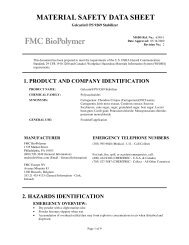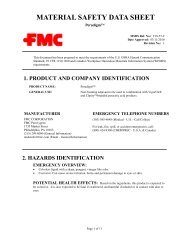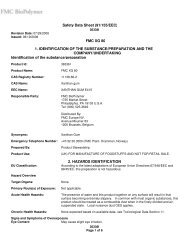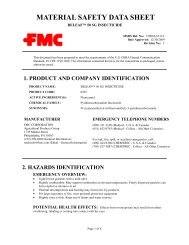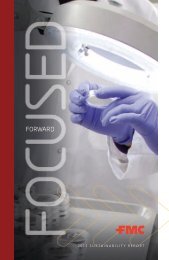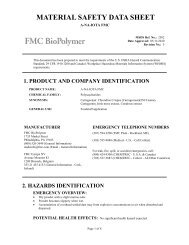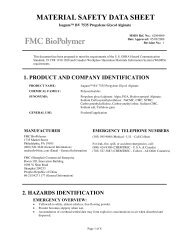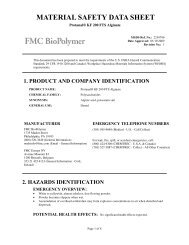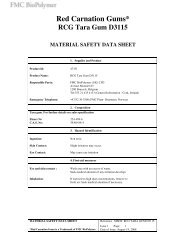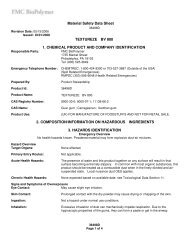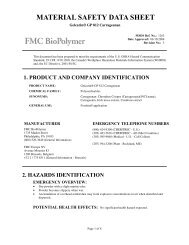CAPTURE® 2 EC INSECTICIDE/MITICIDE - FMC Corporation
CAPTURE® 2 EC INSECTICIDE/MITICIDE - FMC Corporation
CAPTURE® 2 EC INSECTICIDE/MITICIDE - FMC Corporation
You also want an ePaper? Increase the reach of your titles
YUMPU automatically turns print PDFs into web optimized ePapers that Google loves.
<strong>CAPTURE®</strong> 2 <strong>EC</strong> INS<strong>EC</strong>TICIDE/<strong>MITICIDE</strong> (82657-04-3-57) Date: 06/23/2006<br />
DERMAL LD50: > 2,000 mg/kg (rabbit)<br />
ORAL LD50: 262 mg/kg (rat)<br />
INHALATION LC50: 1.86 mg/l (4 h) (rat)<br />
SENSITIZATION: This product produces skin sensitization (allergic reaction) in laboratory<br />
animals, and may produce similar effects in humans.<br />
ACUTE EFF<strong>EC</strong>TS FROM OVEREXPOSURE: This product has moderate oral and,<br />
low dermal and inhalation toxicity. It is minimally irritating to the eyes and non-irritating to the skin. Signs<br />
of toxicity in laboratory animals included tremors, clonic convulsions, ataxia, decreased locomotion,<br />
bloody tears and bloody nasal discharge. Bifenthrin does not cause acute delayed neurotoxicity. Experience<br />
to date indicates that contact with bifenthrin may occasionally produce skin sensations such as rashes,<br />
numbing, burning or tingling. These sensations are reversible and usually subside within 12 hours.<br />
Inhalation of aromatic hydrocarbon vapors may cause dizziness, disturbances in vision, drowsiness,<br />
respiratory irritation, and eye, skin and mucous membrane irritation. Vomiting after ingestion of this<br />
product may cause aspiration of aromatic hydrocarbons into the lungs, which may result in fatal pulmonary<br />
edema. Exposure to butanol vapors may produce headaches, drowsiness and irritation of the nose and<br />
throat. Excessive exposures to butanol liquid or vapors may result in contact dermatitis and irritation of the<br />
mucous membranes.<br />
CHRONIC EFF<strong>EC</strong>TS FROM OVEREXPOSURE: No data available for the<br />
formulation. In studies with laboratory animals, bifenthrin did not cause reproductive toxicity or<br />
teratogenicity. Tremors were associated with repeated exposure of laboratory animals to bifenthrin. In<br />
lifetime feeding studies conducted with rodents, a slight increase in the incidence of urinary bladder tumors<br />
at the highest dose in male mice was considered to be an equivocal response, not evidence of a clear<br />
compound-related effect. The overall absence of genotoxicity has been demonstrated in mutagenicity tests<br />
with bifenthrin. Chronic exposure to aromatic hydrocarbons may cause headaches, dizziness, loss of<br />
sensations or feelings (such as numbness), and liver and kidney damage. Inhalation of xylene vapors at high<br />
doses has also resulted in an increased incidence of malformations and decreases in fetal weight in<br />
laboratory animals. Damage from xylene may be potentiated by alcohol. Disturbances in hearing and<br />
balance have been reported in workers exposed to butanol vapors. Under the conditions of 2-year inhalation<br />
studies, conducted by the National Toxicology Program (NTP), there was clear evidence of carcinogenic<br />
activity of ethylbenzene in male rats based on increased incidences of renal tubule neoplasms. The<br />
incidences of testicular adenoma were also increased. There was some evidence of carcinogenic activity in<br />
female rats based on increased incidences of renal tubule adenomas. There was some evidence of<br />
carcinogenic activity in male mice based on increased incidences of alveolar/bronchiolar neoplasm. There<br />
was some evidence of carcinogenic activity in female mice based on increased incidences of hepatocellular<br />
neoplasms. Studies conducted by the International Agency for Research on Cancer (IARC) showed that<br />
there is inadequate evidence in humans for the carcinogenicity of ethylbenzene and that there is sufficient<br />
evidence in experimental animals; therefore, the overall evaluation shows that ethylbenzene is possibly<br />
carcinogenic to humans (Group 2B).<br />
CARCINOGENICITY:<br />
Chemical Name IARC NTP OSHA Other<br />
Ethylbenzene Listed Listed Not listed (ACGIH) Not listed<br />
Page 6 of 14



